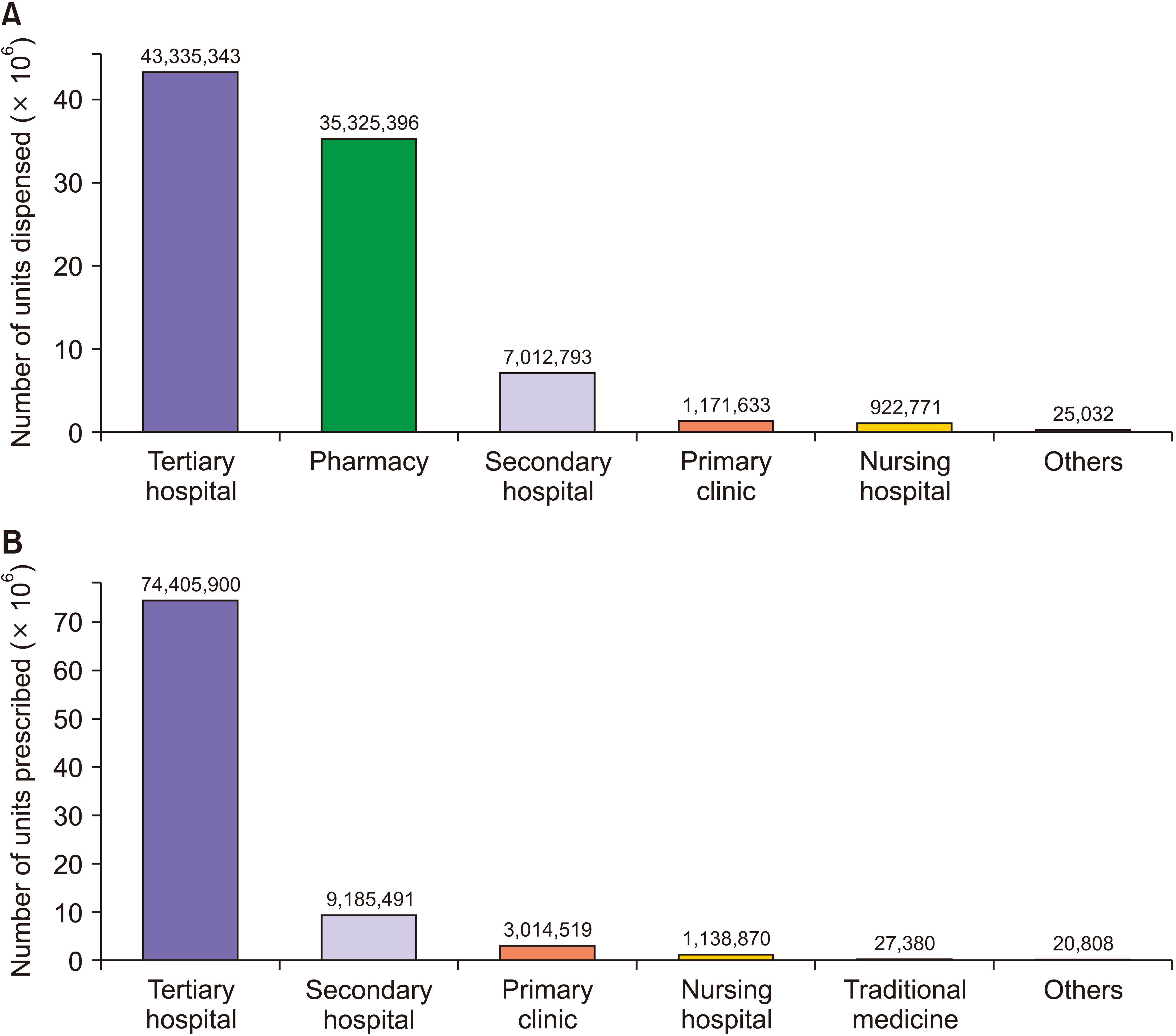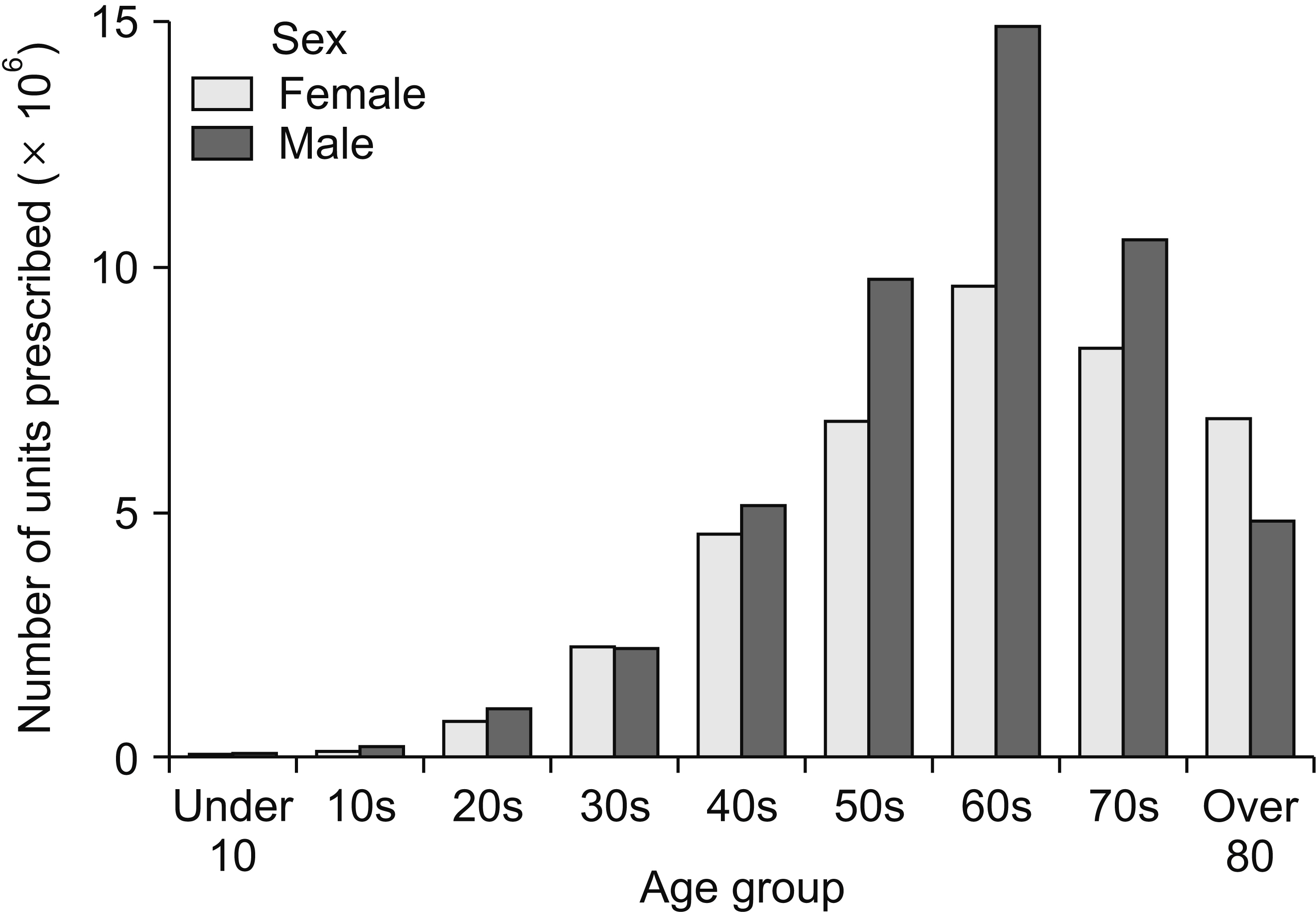Korean J Pain.
2024 Jan;37(1):41-50. 10.3344/kjp.23234.
Current status of opioid prescription in South Korea using narcotics information management system
- Affiliations
-
- 1Department of Anesthesiology and Pain Medicine, Seoul National University Hospital, Seoul, Korea
- 2Department of Anesthesiology and Pain Medicine, Seoul National University College of Medicine, Seoul, Korea
- KMID: 2550131
- DOI: http://doi.org/10.3344/kjp.23234
Abstract
- Background
Recognizing the seriousness of the misuse and abuse of medical narcotics, the South Korean government introduced the world's first narcotic management system, the Narcotics Information Management System (NIMS). This study aimed to explore the recent one-year opioid prescribing patterns in South Korea using the NIMS database.
Methods
This study analyzed opioid prescription records in South Korea for the year 2022, utilizing the dispensing/ administration dataset provided by NIMS. Public data from the Korean Statistical Information Service were also utilized to explore prescription trends over the past four years. The examination covered 16 different opioid analgesics, assessed by the total number of units prescribed based on routes of administration, type of institutions, and patients’ sex and age group. Additionally, the disposal rate for each ingredient was computed.
Results
In total, 206,941 records of 87,792,968 opioid analgesic units were analyzed. Recently, the overall quantity of prescribed opioid analgesic units has remained relatively stable. The most prescribed ingredient was oral oxycodone, followed by tapentadol and sublingual fentanyl. Tertiary hospitals had the highest number of dispensed units (49.4%), followed by community pharmacies (40.2%). The highest number of prescribed units was attributed to male patients in their 60s. The disposal rates of the oral and transdermal formulations were less than 0.1%.
Conclusions
Opioid prescription in South Korea features a high proportion of oral formulations, tertiary hospital administration, pharmacy dispensing, and elderly patients. Sustained education and surveillance of patients and healthcare providers is required.
Keyword
Figure
Reference
-
1. Macintyre PE, Quinlan J, Levy N, Lobo DN. 2022; Current issues in the use of opioids for the management of postoperative pain: a review. JAMA Surg. 157:158–66. DOI: 10.1001/jamasurg.2021.6210. PMID: 34878527.2. Degenhardt L, Grebely J, Stone J, Hickman M, Vickerman P, Marshall BDL, et al. 2019; Global patterns of opioid use and dependence: harms to populations, interventions, and future action. Lancet. 394:1560–79. DOI: 10.1016/S0140-6736(19)32229-9. PMID: 31657732.3. Walther Global Palliative Care & Supportive Oncology. 2022. Essential controlled medicines consumption data trends from 1985 to 2020 (Republic of Korea) [Internet]. Indiana University Simon Comprehensive Cancer Center;Available at: https://walthercenter.iu.edu/essential-medicines/country/republic-korea.html.4. Supreme Prosecutor's Office. 2023. Domestic narcotic drug crime report (2022) [Internet]. Supreme Prosecutor's Office;Available at: https://www.spo.go.kr/site/spo/ex/board/List.do?cbIdx=1204&site=mapping_hyperlink.5. The Catholic University of Korea. 2021. The survey of drug users in Korea 2021 [Internet]. National Center for Mental Health;Available at: https://mhs.ncmh.go.kr/research/4?mid=a10201000000&seq=15.6. Kim MJ, Kim JY, Lim YH, Hong SJ, Jeong JH, Choi HR, et al. 2022; Actual situation and prescribing patterns of opioids by pain physicians in South Korea. Korean J Pain. 35:475–87. DOI: 10.3344/kjp.2022.35.4.475. PMID: 36175347. PMCID: PMC9530690.7. Anderson D, Zlateva I, Khatri K, Ciaburri N. 2015; Using health information technology to improve adherence to opioid prescribing guidelines in primary care. Clin J Pain. 31:573–9. DOI: 10.1097/AJP.0000000000000177. PMID: 25411860. PMCID: PMC4422375.8. Vuolo M, Frizzell LC, Kelly BC. 2022; Surveillance, self-governance, and mortality: the impact of prescription drug monitoring programs on U.S. overdose mortality, 2000-2016. J Health Soc Behav. 63:337–56. DOI: 10.1177/00221465211067209. PMID: 35001700.9. Kim SY, Cho NW, Yoo MS, Han SY, Oh JW. 2023; Narcotics information management system in South Korea: system development and innovation. BMC Health Serv Res. 23:73. DOI: 10.1186/s12913-023-09060-z. PMID: 36694145. PMCID: PMC9872055. PMID: 46c03c21300845c382f6925270638cdb.10. Oh TK, Jeon YT, Choi JW. 2019; Trends in chronic opioid use and association with five-year survival in South Korea: a population-based cohort study. Br J Anaesth. 123:655–63. DOI: 10.1016/j.bja.2019.08.012. PMID: 31558315.11. Cho NR, Chang YJ, Lee D, Kim JR, Ko DS, Choi JJ. 2021; Trends in opioid prescribing practices in South Korea, 2009-2019: are we safe from an opioid epidemic? PLoS One. 16:e0250972. DOI: 10.1371/journal.pone.0250972. PMID: 33979378. PMCID: PMC8115784. PMID: 69d86f514f0541bfa44b009bf800f6cc.12. Korean Statistical Information Service. 2023. Prescription status of medical narcotics by efficacy and constituent [Internet]. Korean Statistical Information Service;Available at: https://kosis.kr/statHtml/statHtml.do?orgId=145&tblId=DT_145013_044&vw_cd=MT_ZTITLE&list_id=F_45_004&scrId=&seqNo=&lang_mode=ko&obj_var_id=&itm_id=&conn_path=MT_ZTITLE&path=%252FstatisticsList%252FstatisticsListIndex.do.13. Kim J, Shin SJ, Yoon J, Kim HS, Lee JW, Kim YS, et al. 2022; Recent trends in opioid prescriptions in Korea from 2002 to 2015 based on the Korean NHIS-NSC cohort. Epidemiol Health. 44:e2022029. DOI: 10.4178/epih.e2022029. PMID: 35209705. PMCID: PMC9117092. PMID: 1c140eab304b41bfa1e15ab7abce5976.14. Kim S, Kim E, Suh HS. 2021; Cost-effectiveness of an opioid abuse-prevention program using the narcotics information management system in South Korea. Value Health. 24:174–81. DOI: 10.1016/j.jval.2020.12.002. PMID: 33518023.15. Kim J, Shin YJ. 2023; Qualitative study on the narcotics information management system (NIMS) experience of doctors and pharmacists using narcotic analgesics. Korean J Clin Pharm. 33:22–34. DOI: 10.24304/kjcp.2023.33.1.22.16. Jayawardana S, Forman R, Johnston-Webber C, Campbell A, Berterame S, de Joncheere C, et al. 2021; Global consumption of prescription opioid analgesics between 2009-2019: a country-level observational study. EClinicalMedicine. 42:101198. DOI: 10.1016/j.eclinm.2021.101198. PMID: 34820610. PMCID: PMC8599097.17. Slivicki RA, Earnest T, Chang YH, Pareta R, Casey E, Li JN, et al. 2023; Oral oxycodone self-administration leads to features of opioid misuse in male and female mice. Addict Biol. 28:e13253. DOI: 10.1111/adb.13253. PMID: 36577735.18. Kirsh K, Peppin J, Coleman J. 2012; Characterization of prescription opioid abuse in the United States: focus on route of administration. J Pain Palliat Care Pharmacother. 26:348–61. DOI: 10.3109/15360288.2012.734905. PMID: 23675595.19. Reddy A, de la Cruz M. 2019; Safe opioid use, storage, and disposal strategies in cancer pain management. Oncologist. 24:1410–5. DOI: 10.1634/theoncologist.2019-0242. PMID: 31097618. PMCID: PMC6853104.20. Cepeda MS, Fife D, Kihm MA, Mastrogiovanni G, Yuan Y. 2014; Comparison of the risks of shopping behavior and opioid abuse between tapentadol and oxycodone and association of shopping behavior and opioid abuse. Clin J Pain. 30:1051–6. DOI: 10.1097/AJP.0000000000000067. PMID: 24370606. PMCID: PMC4232297.21. Wightman R, Perrone J, Portelli I, Nelson L. 2012; Likeability and abuse liability of commonly prescribed opioids. J Med Toxicol. 8:335–40. DOI: 10.1007/s13181-012-0263-x. PMID: 22992943. PMCID: PMC3550270.22. Kuczyńska K, Grzonkowski P, Kacprzak Ł, Zawilska JB. 2018; Abuse of fentanyl: an emerging problem to face. Forensic Sci Int. 289:207–14. DOI: 10.1016/j.forsciint.2018.05.042. PMID: 29902699.23. Lee JH. 2023; Still a threatening opioid wave: it is time for the protagonist to step up! Korean J Pain. 36:1–3. DOI: 10.3344/kjp.22403. PMID: 36581596. PMCID: PMC9812690.24. Butler SF, McNaughton EC, Black RA. 2015; Tapentadol abuse potential: a postmarketing evaluation using a sample of individuals evaluated for substance abuse treatment. Pain Med. 16:119–30. DOI: 10.1111/pme.12524. PMID: 25243972.25. Chang EJ, Choi EJ, Kim KH. 2016; Tapentadol: can it kill two birds with one stone without breaking windows? Korean J Pain. 29:153–7. DOI: 10.3344/kjp.2016.29.3.153. PMID: 27413479. PMCID: PMC4942642.26. Buffington DE, Lozicki A, Alfieri T, Bond TC. 2019; Understanding factors that contribute to the disposal of unused opioid medication. J Pain Res. 12:725–32. DOI: 10.2147/JPR.S171742. PMID: 30863145. PMCID: PMC6388750.27. Ramel CL, Habermann EB, Thiels CA, Dierkhising RA, Cunningham JL. 2020; Provision of a drug deactivation system for unused opioid disposal at surgical dismissal: opportunity to reduce community opioid supply. Mayo Clin Proc Innov Qual Outcomes. 4:357–61. DOI: 10.1016/j.mayocpiqo.2020.04.007. PMID: 32793863. PMCID: PMC7411158.28. Welham GC, Mount JK, Gilson AM. 2015; Type and frequency of opioid pain medications returned for disposal. Drugs Real World Outcomes. 2:129–35. DOI: 10.1007/s40801-015-0019-4. PMID: 26317067. PMCID: PMC4543833.29. Gregorian R, Marrett E, Sivathanu V, Torgal M, Shah S, Kwong WJ, et al. 2020; Safe opioid storage and disposal: a survey of patient beliefs and practices. J Pain Res. 13:987–95. DOI: 10.2147/JPR.S242825. PMID: 32494187. PMCID: PMC7231783.30. Schäfer WLA, Johnson JK, Wafford QE, Plummer SG, Stulberg JJ. 2021; Primary prevention of prescription opioid diversion: a systematic review of medication disposal interventions. Am J Drug Alcohol Abuse. 47:548–58. DOI: 10.1080/00952990.2021.1937635. PMID: 34292095.31. Ministry of Food and Drug Safety. 2013. Article 50 of narcotics control act [Internet]. Korea Ministry of Government Legislation;Available at: https://www.law.go.kr/%EB%B2%95%EB%A0%B9/%EB%A7%88%EC%95%BD%EB%A5%98%EA%B4%80%EB%A6%AC%EC%97%90%EA%B4%80%ED%95%9C%EB%B2%95%EB%A5%A0.32. Chisholm-Burns MA, Spivey CA, Sherwin E, Wheeler J, Hohmeier K. 2019; The opioid crisis: origins, trends, policies, and the roles of pharmacists. Am J Health Syst Pharm. 76:424–35. DOI: 10.1093/ajhp/zxy089. PMID: 31361827.33. Eukel H, Steig J, Frenzel O, Skoy E, Werremeyer A, Strand M. 2020; Opioid misuse and overdose: changes in pharmacist practices and outcomes. J Contin Educ Health Prof. 40:242–7. DOI: 10.1097/CEH.0000000000000317. PMID: 33284175.34. Fayaz A, Croft P, Langford RM, Donaldson LJ, Jones GT. 2016; Prevalence of chronic pain in the UK: a systematic review and meta-analysis of population studies. BMJ Open. 6:e010364. DOI: 10.1136/bmjopen-2015-010364. PMID: 27324708. PMCID: PMC4932255.35. Jensen-Dahm C, Gasse C, Astrup A, Mortensen PB, Waldemar G. 2015; Frequent use of opioids in patients with dementia and nursing home residents: a study of the entire elderly population of Denmark. Alzheimers Dement. 11:691–9. DOI: 10.1016/j.jalz.2014.06.013. PMID: 25239738.36. Levi-Minzi MA, Surratt HL, Kurtz SP, Buttram ME. 2013; Under treatment of pain: a prescription for opioid misuse among the elderly? Pain Med. 14:1719–29. DOI: 10.1111/pme.12189. PMID: 23841571. PMCID: PMC3834188.37. Roberto KA, Teaster PB, Lindberg BW, Blancato R. 2021; A first (and disturbing) look at the relationship between the opioid epidemic and elder abuse: insights of human service professionals. J Appl Gerontol. 40:1231–5. DOI: 10.1177/0733464820947279. PMID: 32772619.38. Yoon D, Lee H, Baek YH, Jeong HE, Shin JY. 2021; Prevalence and its correlation with sustained opioid use in Korea: a group-based trajectory analysis. J Psychoactive Drugs. 53:224–9. DOI: 10.1080/02791072.2020.1856456. PMID: 33295850.39. Litman RS, Pagán OH, Cicero TJ. 2018; Abuse-deterrent opioid formulations. Anesthesiology. 128:1015–26. DOI: 10.1097/ALN.0000000000002031. PMID: 29252508.
- Full Text Links
- Actions
-
Cited
- CITED
-
- Close
- Share
- Similar articles
-
- Narcotics Monitoring with Narcotics Information Management System
- Analysis of Prescription Trends for Narcotic Appetite Suppressants: Utilizing the Narcotics Information Management System
- A Study on the Policy Implication on the Management of Narcotics Distribution for Medical Use
- Education regarding opioid prescription within oral and maxillofacial surgery residency programs: a survey study
- Evaluating Appropriateness of Medication Use in the Operating Rooms of a Tertiary Hospital: Based on Survey




